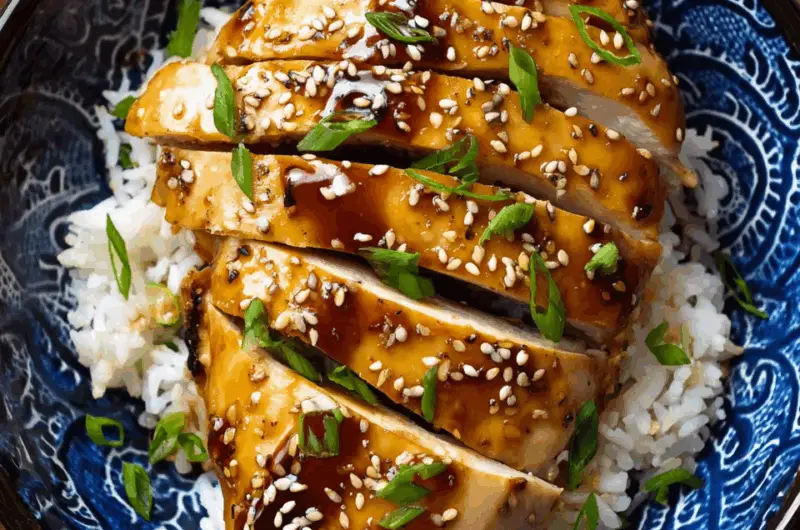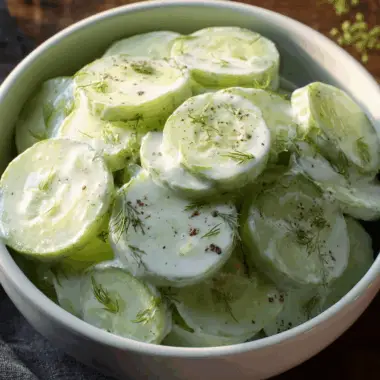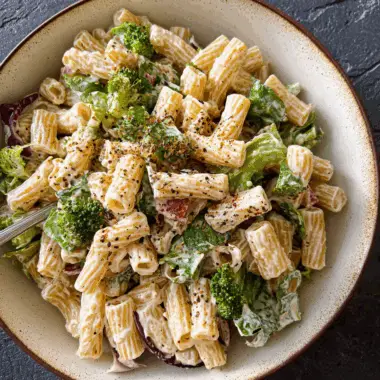The magic of this Teriyaki Chicken lies in its simplicity and depth of flavor. Using pantry staples like soy sauce, sake, mirin, and fresh ginger, the chicken gently poaches in the sauce until succulent and tender. Then, the sauce is reduced into a rich, syrupy glaze that clings beautifully to every slice.
It’s a dish that feels restaurant-worthy but takes minimal time and effort at home. Pair it with fluffy white rice and your favorite steamed vegetables for a satisfying, well-balanced meal. Whether you’re new to Japanese flavors or a seasoned fan, this teriyaki chicken delivers every time.
Full Recipe:
-
3/4 cup soy sauce (or 50/50 tamari and water for gluten-free)
-
3/4 cup sake
-
3/4 cup mirin
-
4 tablespoons sugar
-
1-inch piece of ginger, finely grated
-
1 1/4 to 1 1/2 pounds boneless, skinless chicken breasts
-
2 to 3 tablespoons sesame seeds
Directions:
-
In a saucepan, combine grated ginger, sugar, soy sauce, sake, and mirin. Bring to a boil.
-
Add chicken breasts to the pot, reduce heat to the lowest possible setting, cover, and poach gently for 20 minutes. Larger breasts may require more time or should be halved.
-
While the chicken is cooking, toast sesame seeds in a dry pan over medium heat until golden and fragrant. Set aside.
-
Remove the chicken from the sauce, place on a plate, and cover with foil to keep warm.
-
Return the sauce to a boil and reduce for 8–10 minutes, stirring occasionally, until syrupy.
-
Slice the chicken, drizzle with the reduced teriyaki glaze, sprinkle with toasted sesame seeds, and serve with steamed rice.
Prep Time: 10 minutes | Cooking Time: 30 minutes | Total Time: 40 minutes
Kcal: 555 kcal | Servings: 4 servings
The Art of Teriyaki Chicken: A Classic with Modern Convenience
Teriyaki Chicken has long been a beloved staple in both traditional Japanese cuisine and international kitchens. Its unmistakable balance of sweet and savory flavors, silky glaze, and tender texture make it a favorite for home cooks and restaurant chefs alike. The version of Teriyaki Chicken made with boneless, skinless chicken breasts, gently poached in a homemade sauce and finished with toasted sesame seeds, brings a modern, health-conscious twist to this iconic dish — without compromising on taste.
This version is especially appealing for those who need a quick, yet impressive meal on the table. With only a few pantry staples like soy sauce, mirin, sake, sugar, and fresh ginger, it becomes effortless to prepare a dish that tastes like it took hours to perfect.
Origins and Meaning of Teriyaki
The term “teriyaki” comes from two Japanese words: teri meaning “gloss” or “shine,” and yaki meaning “grill” or “broil.” It refers to the way the sauce coats the food with a lustrous sheen during cooking. While traditionally applied to fish like yellowtail or mackerel in Japanese households, Western interpretations of teriyaki often focus on proteins like chicken, beef, or salmon, which adapt beautifully to the glaze.
In Japan, teriyaki isn’t a bottled sauce—it’s a cooking method. The homemade sauce is always made fresh, combining umami-rich soy sauce with the subtle sweetness of mirin and sake. These ingredients not only contribute to the deep flavor of the dish but also bring authenticity to every bite.
Why Use Chicken Breasts?
Traditional teriyaki chicken often uses thigh meat for its juicy texture, but this version spotlights the leaner chicken breast. The secret to keeping chicken breasts moist lies in the technique: poaching them gently in the teriyaki sauce instead of frying or grilling them intensely. This slow, gentle cooking ensures the meat stays succulent and doesn’t dry out—a common issue with this cut.
Cooking the chicken directly in the sauce also infuses it with flavor from the inside out. Unlike methods where the sauce is added only at the end, this approach uses the sauce as both a cooking medium and a final glaze.
The Importance of Poaching in Sauce
Poaching is a technique that’s often underused in home kitchens, especially for meat dishes. It’s a method where the food is cooked gently in a simmering liquid—never a rolling boil—until perfectly done. In this case, the teriyaki sauce serves as both flavor and cooking liquid.
Not only does poaching help retain the natural moisture of the chicken, but it also allows the proteins to gradually absorb the umami and sweetness of the sauce. The final touch of reducing the sauce after removing the chicken enhances the concentration of flavors and gives you that thick, shiny coating so essential to any teriyaki dish.
A Healthier Approach to Teriyaki
One of the standout aspects of this dish is its health-conscious preparation. There’s no frying or oil involved. The use of lean chicken breasts makes it lower in fat compared to thigh-based versions, while still providing a high protein content.
Additionally, using natural, unprocessed ingredients for the teriyaki sauce helps you avoid excess preservatives and additives found in many commercial bottled sauces. For those watching their sodium intake, the soy sauce can be substituted with a low-sodium version or cut with water, while tamari can be used for a gluten-free alternative.
Toasting Sesame Seeds: Small Step, Big Flavor
Toasted sesame seeds are more than just a garnish in this dish—they’re a key flavor note. Toasting them briefly in a dry skillet awakens their nutty aroma and intensifies their taste, providing a contrasting crunch to the soft, glazed chicken. It’s a simple step that adds both flavor and texture, making the overall dish more dynamic and satisfying.
Pairing Suggestions and Meal Ideas
This teriyaki chicken is a versatile centerpiece for countless meals. Traditionally served with plain steamed white rice, it also works well with jasmine or brown rice for added nutrition. If you want to keep the meal low-carb, serve the chicken alongside cauliflower rice or stir-fried greens like bok choy, spinach, or broccoli.
For a heartier Japanese-inspired meal, consider pairing it with miso soup, pickled vegetables, or a cucumber-wakame salad. It’s also great in lunch boxes or meal prep containers, as the sauce holds up well over time and even intensifies in flavor the next day.
You can also slice the chicken and use it in rice bowls, noodle dishes, or even wraps. For a Western-style fusion twist, try adding it to a sandwich with pickled cabbage and spicy mayo.
Customizing the Flavor
One of the best things about this recipe is how adaptable it is to your flavor preferences. Want it sweeter? Add a bit more sugar or honey. Prefer a hint of heat? Stir in a touch of chili paste or a few flakes of red pepper. Craving more aromatics? Toss in garlic with the ginger.
If sake or mirin is not available, you can still recreate a similar flavor profile. Replace sake with dry sherry or a mild white wine, and use a mix of rice vinegar and sugar to mimic mirin’s delicate sweetness.
This flexibility allows home cooks to enjoy the elegance of teriyaki while making it their own.
Cooking Tips for Perfect Teriyaki Chicken Every Time
-
Don’t rush the poach: Make sure the chicken is simmered gently, not boiled. A low, steady heat ensures tenderness.
-
Reduce with care: Keep a close eye when reducing the sauce. It can quickly over-thicken or burn if left unattended.
-
Slice after resting: Let the chicken rest under foil for a few minutes before slicing. This locks in the juices.
-
Adjust for dietary needs: Use tamari or coconut aminos for a gluten-free version. Sweeteners like honey or maple syrup can be used in place of sugar for a more natural approach.
How This Dish Appeals to Modern Lifestyles
In today’s fast-paced world, this recipe checks all the right boxes: it’s quick (ready in under 40 minutes), healthy, budget-friendly, and doesn’t require exotic ingredients. It’s ideal for meal prepping and easily scaled up or down depending on the size of your household.
Whether you’re cooking for one, a family of four, or prepping meals for the week ahead, this dish adapts to your needs without sacrificing flavor.
Conclusion: The Elegance of Simplicity
Teriyaki Chicken Breasts poached in a homemade sauce and finished with sesame seeds is a celebration of balance, technique, and taste. It’s a dish that brings together the richness of Japanese culinary tradition with the efficiency modern cooks crave.
By mastering this recipe, you don’t just learn how to make a tasty meal—you understand how gentle cooking, thoughtful ingredients, and small details like sesame toasting can elevate everyday food into something memorable.
Whether it becomes your go-to weeknight dinner or your signature lunchbox hero, this Teriyaki Chicken is bound to earn a spot in your regular rotation. Elegant enough to impress, simple enough to make again and again—this is teriyaki done right.







